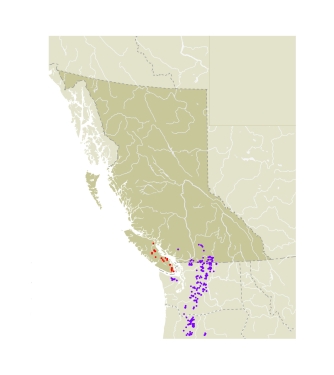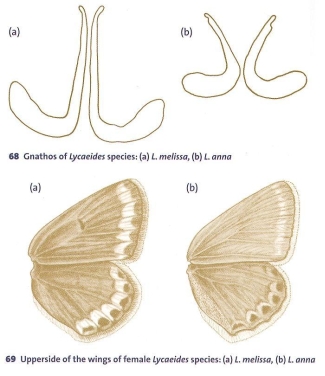AdultThis blue is characterized by the very white underside ground colour, which has a blue flush at the base of the ventral hindwing. The black spot pattern is very obscure compared with that in other species in the genus. The genitalia are nearly identical to those of L. idas. Besides the wing pattern differences, this species has a very different larval foodplant from L. idas.
Immature StagesUndescribed.
SubspeciesMainland populations are the Cascade Mountains subspecies, L.a. ricei (Cross, 1937) (TL: Big Cultus Lake, Deschutes Co., OR). The Vancouver Island subspecies is a new subspecies, which, in the older British Columbia literature, was identified as L.a. anna or L. melissa (Shepard 1964).
Lycaeides anna vancouverensis Guppy & Shepard, new subspecies. The upperside of the male wings is a uniform blue. There is almost no evidence of black marks in the submarginal area. The ventral hindwing has a blue flush on the basal half, a characteristic of the species. The postmedian black spots on the underside of both wings are much larger than in L.a. ricei. The inner submarginal orange spots on the underside of both wings is much stronger than in L.a. ricei. In this way L.a. vancouverensis is closer in appearance to California subspecies of L. anna and L. melissa. Females have the same strong postmedian black spots and strong inner submarginal orange spots as the males. On the upperside of the female wings, the submarginal orange spots are always large on the hindwing and usually so on the forewing. This is in contrast to the subspecies L.a. ricei, where these submarginal orange spots are weak to absent on both surfaces of the wings. Types. Holotype: male, BC, Strathcona Park, Cream Lake, 1,400 m, 22 August 1988, C.S. Guppy. A label "Holotype / Lycaeides anna / vancouverensis Guppy & Shepard" is attached. The holotype is deposited in the Royal British Columbia Museum, Victoria, BC, CAN. Paratypes: 27 males, 23 females, same data as holotype (CSG); 2 males, 2 females, same data as holotype (JHS); 1 female, BC, Strathcona Park, Flower Ridge, 4,600 ft., 11 August 1974, C.S. Guppy (CSG); 2 males, 6 females, BC, Mt. Cokely Ski Hill Rd., 3 August 1995,J. and S. Shepard (JHS); 1 female, same locality, 26 July 1995, J. and S. Shepard (JHS); 6 males, 6 females, BC, Mt. Cokely summit, 1,600 m, 12 August 1977. C.S. Guppy (CSG); 1 female, BC, Sproat lake (north side), 10 June 1975, C.S. Guppy (CSG).

